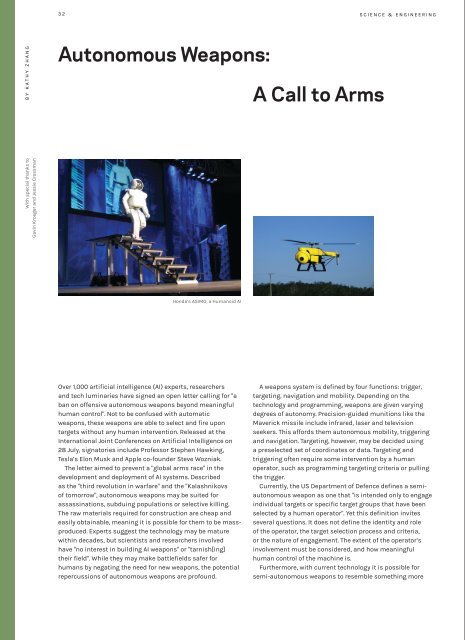Lot's Wife Edition 6 2015
Create successful ePaper yourself
Turn your PDF publications into a flip-book with our unique Google optimized e-Paper software.
32<br />
SCIENCE & ENGINEERING<br />
BY KATHY ZHANG<br />
Autonomous Weapons:<br />
A Call to Arms<br />
With special thanks to<br />
Gavin Kroeger and Jessie Crossman<br />
Honda’s ASIMO, a Humanoid AI<br />
Over 1,000 artificial intelligence (AI) experts, researchers<br />
and tech luminaries have signed an open letter calling for "a<br />
ban on offensive autonomous weapons beyond meaningful<br />
human control". Not to be confused with automatic<br />
weapons, these weapons are able to select and fire upon<br />
targets without any human intervention. Released at the<br />
International Joint Conferences on Artificial Intelligence on<br />
28 July, signatories include Professor Stephen Hawking,<br />
Tesla’s Elon Musk and Apple co-founder Steve Wozniak.<br />
The letter aimed to prevent a "global arms race" in the<br />
development and deployment of AI systems. Described<br />
as the "third revolution in warfare" and the "Kalashnikovs<br />
of tomorrow", autonomous weapons may be suited for<br />
assassinations, subduing populations or selective killing.<br />
The raw materials required for construction are cheap and<br />
easily obtainable, meaning it is possible for them to be massproduced.<br />
Experts suggest the technology may be mature<br />
within decades, but scientists and researchers involved<br />
have "no interest in building AI weapons" or "tarnish[ing]<br />
their field". While they may make battlefields safer for<br />
humans by negating the need for new weapons, the potential<br />
repercussions of autonomous weapons are profound.<br />
A weapons system is defined by four functions: trigger,<br />
targeting, navigation and mobility. Depending on the<br />
technology and programming, weapons are given varying<br />
degrees of autonomy. Precision-guided munitions like the<br />
Maverick missile include infrared, laser and television<br />
seekers. This affords them autonomous mobility, triggering<br />
and navigation. Targeting, however, may be decided using<br />
a preselected set of coordinates or data. Targeting and<br />
triggering often require some intervention by a human<br />
operator, such as programming targeting criteria or pulling<br />
the trigger.<br />
Currently, the US Department of Defence defines a semiautonomous<br />
weapon as one that "is intended only to engage<br />
individual targets or specific target groups that have been<br />
selected by a human operator". Yet this definition invites<br />
several questions. It does not define the identity and role<br />
of the operator, the target selection process and criteria,<br />
or the nature of engagement. The extent of the operator’s<br />
involvement must be considered, and how meaningful<br />
human control of the machine is.<br />
Furthermore, with current technology it is possible for<br />
semi-autonomous weapons to resemble something more

















